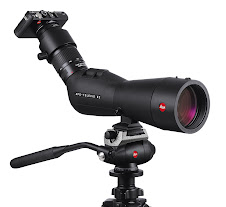 brand NEW Leica V-Lux 20 compact superzoom point & shoot camera
brand NEW Leica V-Lux 20 compact superzoom point & shoot camera I was working the "Biggest Week in American Birding" in Ohio last week and the local sales rep loaned me his sample of the new Leica V-Lux 20 to test. I fully expected that I would be able to use the 12x zoom (300 mm equivalent) effectively to capture images of closer birds seen along the boardwalk at Magee Marsh in Oak Harbor, OH. This was a certainty and the camera performed "spot on" in this regard. At 14.5 megapixels with high def movie mode and built in GPS, I was looking forward to playing with this and as you can see from the image of below I was not disappointed!
 male Northern Parula image taken with the new Leica V-Lux 20 camera 5/14/10
male Northern Parula image taken with the new Leica V-Lux 20 camera 5/14/10
The colorful male Northern Parula shown above was taken by simply holding this tiny pocket-sized camera up, zooming and snapping the image! Obviously the bird cooperated by being close and at eye-level, but that is why so many birders visit this gem of a site during spring migration; for "in-your-face" views of these vibrant migrant birds. (taken at max zoom - 300 mm, program mode, ISO 200, 1/250th sec, f/4.9, +1 ev, with optical image stabilization and built in flash activated for fill).
Purple Martin pair @ Oak Harbor, OH 5/13/10
Those who know me, know that I am a digiscoping freak so despite the fact that "superzoom" cameras don't lend themselves to digiscoping, I'm sure you know I had to try this new "compact superzoom" behind our new wide-angle scope eyepiece to see how it worked for myself! The above is the exact image completely unaltered that I took through the scope when I first tried this on the evening of 5/13/10.
Amazingly, the Leica V-Lux 20 broke all the digiscoping rules and actually worked f0r digiscoping on its first test above. I was completely stoked! This was handheld behind the Leica APO Televid spotting scope with the wide-angle zoom eyepiece set a bit over 25x and the camera zoom set at a 35 mm equivalent.
 Purple Martin pair digiscoped with NEW Leica V-Lux 20 camera
Purple Martin pair digiscoped with NEW Leica V-Lux 20 camera
With 14.5 megapixel at my disposal, I was easily able to crop up and eliminate the dark circular frame to capture both the male & female birds (above) and then cropping further even the female alone as below!

female Purple Martin cropped from digiscoped image above
On the way back to the car (near 7 PM), I found my next photo opportunity and tested my luck again. A male Baltimore Oriole was singing unabashedly in an oak tree at the edge of the parking lot. I quickly set up my scope, pulled the V-Lux out of my shirt pocket and held it behind the scope eyepiece. This time I had the scope zoom at minimum 25x, and there was no vignetting around the frame! The image below is again completely unaltered. This is as it turned out by simply holding the new V-Lux 20 to the wide-angle eyepiece and shooting the image! Note there is just the tiniest hint of black vignetting at the lower right corner but otherwise nothing. adult male Baltimore Oriole digiscoped with Leica V-Lux 20 evening 5/13/10
adult male Baltimore Oriole digiscoped with Leica V-Lux 20 evening 5/13/10
Image properties:
ISO 200
shutter speed: 1/80th sec
f/3.5
+0.7 step EV
35 mm equivalent

Baltimore Oriole digiscoped image slightly altered.
In the above image I've taken the liberty to add ~10 seconds of photoshop magic, cropping slightly to eliminate the dark corner and some of the "blown out" sky , and adding a bit of "shadow/highlights", but nothing more for the finished look above. At any rate, it is clear I need to get a V-Lux 20 of my own and begin experimenting some more both behind the spotting scope and as a stand alone unit! On 5/14 & 15 I took some more and better images and videos using the same camera scope combination which I will highlight next!
 handheld digiscoped imagetaken with new Leica V-Lux 20 at 75 mm equivalent
handheld digiscoped imagetaken with new Leica V-Lux 20 at 75 mm equivalent Eastern Wood-Pewee digiscoped w/ Leica V-Lux 20 through APO Televid scope
Eastern Wood-Pewee digiscoped w/ Leica V-Lux 20 through APO Televid scope Eastern Wood-Pewee digiscoped Magee Marsh, OH 5/14/10
Eastern Wood-Pewee digiscoped Magee Marsh, OH 5/14/10 male Cape May Warbler digiscoped through Leica APO Televid 82 w/ V-Lux 20
male Cape May Warbler digiscoped through Leica APO Televid 82 w/ V-Lux 20







